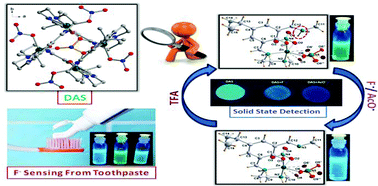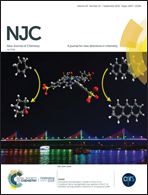A macrocyclic tetranuclear ZnII complex as a receptor for selective dual fluorescence sensing of F− and AcO−: effect of a macrocyclic ligand†
Abstract
A 48-membered macrocyclic ZnII-Schiff base complex DAS (Dual Anion Sensor) containing protonated imine has been synthesized and characterised. The single crystal X-ray structural analysis reveals a tetranuclear complex cation [Zn4(LH3)(NO3)5]2+ counterbalanced by a [Zn(NO3)4]2− anion. DAS acts as a dual anion sensor which can selectively detect fluoride and acetate in aqueous methanolic solution by change in UV-vis spectra as well as by fluorescence enhancement. A probable mechanistic pathway has been proposed and DFT calculations corroborate well with the experimental data. The calculated limit of detection for F− and AcO− ions was 0.18 and 1.98 μM, and 0.15 and 1.8 μM from UV and FL data, respectively. Interestingly, DAS behaves as an INHIBIT logic gate with F−/AcO− and H+ as inputs. To the best of our knowledge, this is the first example where a macrocyclic Zn-complex serves as an INHIBIT logic gate. Practical utility of DAS has been explored by successful detection of F− in commercially available toothpaste as well as solid state detection of F− and AcO−.



 Please wait while we load your content...
Please wait while we load your content...